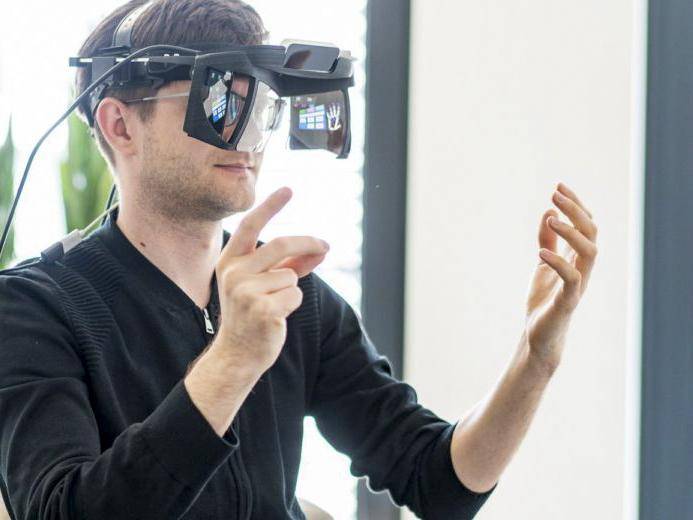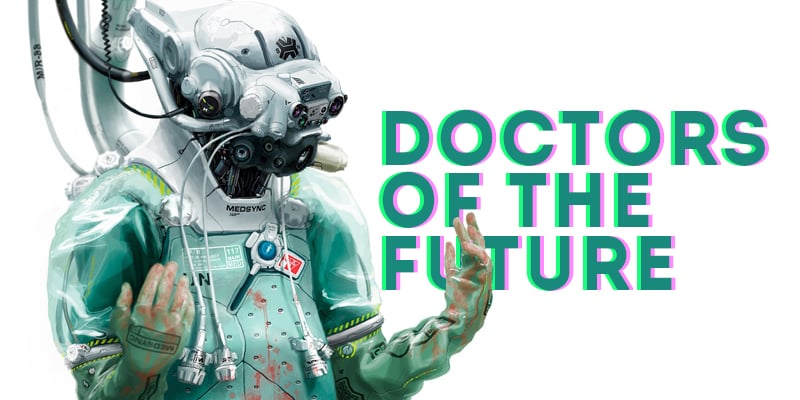Imagine the year is 2036. Dr. James Mitchell, a rheumatologist with his private practice for 20 years, has just woken up from a 7 hour 20-minute long sleep as his iPhone 24 tells him. While shaving, he listens to the daily news, customized for him according to his interests. He hears that among others, the first clinical trial for the personalized anti-interferon treatment of dsDNA positive SLE patients has met its primary endpoint at record speed thanks to the advances in quantum computing.
For breakfast, he decides against the croissant but for a bowl of cereals. His smartphone camera had detected early signs of dyslipidemia in the retinal scan he had performed. His cholesterol levels are still within the normal range, but with the early alterations in the scan, he decided to cut back a little. His smart ARglasses register his calorie automatically, and micronutrient intake, 24% of his daily calorie requirements, are already covered.
The sun is shining, and James decides to turn on his daily motivational podcasts and walks to work. He continually struggles to reach his personal daily step goal; secondly, it is time for his movement analysis, performed by the sensors integrated into his clothing. He felt his hips moving asymmetrically in the last days and wonders if he is right. His thoughts wander to his patient, whose abnormal walking patterns led to ankylosing spondylitis diagnosis despite the lack of any pain.

Once at his practice, his assistant has already started the computer. He logs into the digital system, which connects all physicians and hospitals and allows access to the patients’ health data. Abnormal electronic patient-reported outcomes and laboratory values pop up. James scrolls through them: His lupus patients’ smart toilet had detected an increase in proteinuria without leukocyturia. A patient with rheumatoid arthritis (RA) had marked her pain at ten on a visual analog scale. Since she has had this amount of pain for three days now, the system automatically goes to red alert. The third one is a patient with alarmingly high values on the depression scale—his office schedules teleconsultations with all patients for the afternoon.
At 10 am, James starts with his consultations. His first patient is Bill. Bill’s electronic health record provides James the following information: 39-year-old male with ankylosing spondylitis, treated with TNF-alpha inhibitor, last visit four months ago, stable disease for five years. Furthermore, his data show that he had average lab values in the last 16 months and that his BASDAI and his HAQ, which he filled out via his smartphone at home two days ago, have also been fine for the last nine months. His shoulder injury and spine mobility app shows general spine mobility of 92%. James asks the patient in, and he tells him that he is feeling well apart from increased fatigue and some sleep issues. He provides him with his smart sleep mattress sensor results, which shows a decrease in sleep quality and a quantity of 14% in the last four months. He further reports that he has been doing his virtual yoga classes, which James had prescribed, rarely lately due to the high level of work-related stress. James is generally satisfied with the test results, and briefly discusses the results of his last blood tests and his phone App. Since the sleep issues seem to be stress-related, he stresses the need for regular physical exercise and relaxation.
James agrees that fewer follow-up appointments are necessary as there is a stable remission, and the next appointment can be made from home in 4 months by video consultation. James sends him a new prescription via push email. Next to his medication, this also includes a recommendation for a meditation and mindfulness app and a new virtual reality (VR) yoga course, which he can access at home. A second push email with an automatic reminder function informs the patient about his next appointment.
The second patient is Shiela. James’s tablet informs him that this is her first contact with a rheumatologist, that she is 31 years old, has no previous illnesses; she is a non-smoker, and works as a kindergarten teacher. For four months, she complained about increased fatigue, morning stiffness of the hands, and the MCP joints’ arthralgia with discreet swelling. Following the symptom checker app, which calculated RA’s suspected diagnosis with a probability of 35%, her GP had taken blood three weeks ago, and rheumatoid factors and CRP were slightly elevated. Including her antibody positivity, the app now shows a probability of 90% for the presence of RA. Therefore her GP had digitally made an appointment with James. As part of the early arthritis screening consultation, the nurses at James’s practice have already taken a joint status and a blood test, including CRP quick test, which is also positive. This is followed by an automatic ultrasound scan of the hands, which shows synovitis of the MCP II, III, and IV joints of both hands.
He studies all the information on his tablet, which now gives a probability of 94% for the presence of RA and an electronic disease activity index of 9 before James even sees the patient. As she enters the office, James examines her and confirms the diagnosis RA. Based on Laura’s health data, Jamess computer has already identified the optimal therapeutic reagent for her disorder, and they discuss the medications. Thanks to highly personalized autoimmune disease treatments, the need for therapy changes has decreased significantly, he thinks. Since Laura suspected her diagnosis before her consultation due to her app results, she has informed herself in advance on the internet. James sends her the link to an RA information program. This should answer all her questions as it includes a one-hour information video about RA and digital tutorials about physical activity, nutrition, pregnancy, and vaccination. Also, it emphasizes the importance of the early RA monitoring program that includes wearing a digital sensor to measure activity and sleep.
The third patient is Shiela, a young woman of 34 years with systemic lupus erythematosus who had uploaded pictures of her skin into her health record. Automatically, James was informed that her skin has deteriorated. Furthermore, her automated ultrasound device had detected pleural and pericardial effusions. Shiela has already received all suitable treatment options for her, but she is one of the rare cases in which remission is difficult to obtain. James still remembers the old days in which treatment options for SLE were so limited that remission off steroids was hardly achieved for anybody; how times have changed!
Nonetheless, Shiela is a difficult case, and James starts a system query with the integration of all her previous data, including failed treatments and relevant medical data. The machine learning algorithm, which integrates the latest literature, suggests CAR-T cell therapy as an option based on Ellie’s genetic profile and high autoantibody production levels. Although the algorithm has outperformed many expert opinions previously, James decides to discuss this case in his digital expert board this afternoon.
James sees more patients until noon. After lunch, he starts with his teleconsultations. Miss Jennifer, a longstanding RA patient, who was just switched to a novel tyrosine kinase inhibitor, has a tremendous therapeutic response, measured by her daily hand scan. Therefore, they discuss her steroid reduction scheme. Another lady had performed a voice analysis that found signs suggestive of granulomatosis with polyangiitis. She was directly referred to her symptom checker app, which found only a 4% chance for GPA. James reassures her that voice analysis, although already validated for cardiovascular disease, is still in the early stages of development for other diseases, and results must be treated with caution. Furthermore, he speaks to his patients with abnormal results reported this morning and throughout the day. If necessary, he schedules face-to-face appointments with them.
At 4 pm, it is time for the digital expert board on personalized therapies. International rheumatology experts, as well as other disciplines such as digital data experts, join the meeting. Cases are presented, discussed, and treated and followed-up by the most suitable reference center via teleconsultations. Regarding his patient, Jennifer, CAR T-cell therapy is considered the most suitable option, but all agree that close monitoring is mandatory.
On his way home, he reflects how his job has changed in recent years. Today he sees himself clearly as a healthcare manager. The use of collected data, instantly available, automated laboratory and imaging diagnostics, and, of course, the use of wearables and artificial intelligence (AI) have fundamentally changed rheumatology. Sometimes he thinks back to his years as a young professional when he saw many patients with deformed hands. A rheumatic diagnosis often meant disability and early retirement. Back then, his job was more of a sick care manager trying to reduce damage. Fortunately, these years are over as modern technology takes over many of his automatic documentation via voice control, automated diagnostics via AI-algorithm, digital billing, and appointment scheduling. Now he has more time to focus on the patient’s problems, react spontaneously, and adapt to the situation depending on the objective urgency.
In the past, it was much harder for him to communicate with colleagues. Today, he is digitally connected with colleagues from all over the world almost every day. Even though he had difficulties, in the beginning, to keep up with the speed of digital changes and the rapid growth of knowledge, primarily through AI, he can now update his knowledge every week using individualized digital medical channels. He thinks of a quote from medical school, which he heard this morning in his motivational theme podcasts:
“Medicine aims to prevent disease and prolong life; the ideal of medicine is to eliminate the need of a physician.”
Medicine has definitely changed in recent years: His patients still need him as a rheumatologist, counselor, contact person, and therapist. But much more to maintain their state of health than to treat their illness. Many patients need him less frequently, and he has more time today than in the past for those who are seriously ill.

